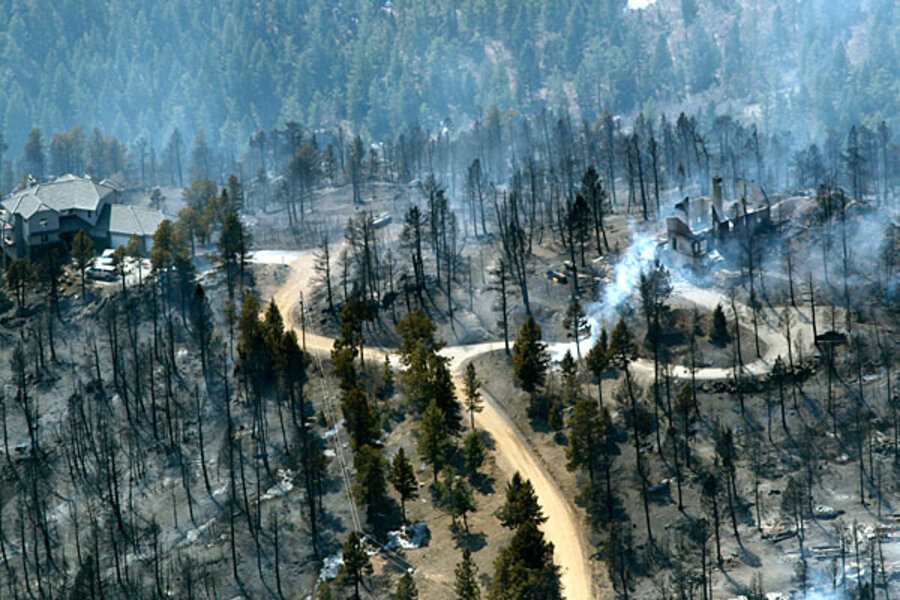Federal crews plan to contain wildfire in Colorado
Loading...
| Conifer, Colo.
Federal fire crews are planning to take the offensive in containing a 7-square-mile blaze that may have claimed two lives and destroyed dozens of homes in the mountains southwest of Denver.
Firefighters are hoping to start containing at least part of a mountain wildfire that forced hundreds of residents to flee, damaged 28 homes and may have caused the deaths of two people.
Investigators on Tuesday were trying to determine whether a controlled burn designed to minimize wildfire risk reignited and became a stubborn mountain wildfire.
Federal agencies dispatched two large air tankers to tackle the blaze that resulted in mandatory evacuations of 900 homes south of the commuter town of Conifer, about 8,200 feet up in the Rockies foothills and 25 miles southwest of downtown Denver.
IN PICTURES: Colorado wildfires
Some 450 firefighters from Colorado, Idaho, Nevada and Utah were sent to assist 250 firefighters on the ground.
The fire consumed grass, brush and some Ponderosa Pine tree canopies. Winds were 20 mph to 30 mph before calming late Tuesday.
Denver's tightly populated southwestern suburbs were not threatened.
Jefferson County sheriff's spokeswoman Jacki Kelley said the wildfire may have sprung from a controlled burn. The Colorado State Forest Service did conduct a 35-acre burn in the region on Thursday — on land belonging to Denver's water authority — said forest service spokesman Ryan Lockwood. By destroying shrubs and woods in a controlled burn, there should be less material to fuel a wildfire.
Crews finished the effort on Friday and patrolled the 35-acre perimeter daily to ensure it was out, Lockwood said. It was during Monday's patrol that a state forest service crew spotted the wildfire — also on Denver Water property — alerted authorities, and began fighting it, Lockwood said. It wasn't clear if the wildfire was inside the controlled burn zone.
The Jefferson County sheriff's office will determine the cause of the blaze, while the Colorado State Forest Service was conducting its own review, Lockwood said.
Stacy Chesney, a spokeswoman for Denver Water, said the agency was "trying to be proactive" to protect water supplies from soil runoff caused by deforestation.
The area has several watersheds that feed metropolitan Denver and is several miles from the location of the 2002 Hayman fire, one of Colorado's worst, which destroyed 133 homes and 466 outbuildings over 215 square miles.
Protocols for controlled fires include monitoring them until they are determined to be cold — meaning nothing is at risk for reigniting, said Roberta D'Amico, spokeswoman for the National Interagency Fire Center in Boise, Idaho.
Fire officials normally check weather, terrain and other factors to create a burn plan and alert municipal authorities, D'Amico said.
Carole Walker, director of the Rocky Mountain Insurance Information Association, said state agencies have limited immunity for performing regular duties.
"They have immunity on the duties of managing a forest. It would have to be determined they were negligent or acting outside their duties" for property owners to seek compensation, Walker said.
Officials found the bodies of a man and woman at a destroyed home, said Daniel Hatlestad of the Jefferson County Incident Management Team. They were identified as Sam Lamar Lucas, 77, and Linda M. Lucas, 76. A cause of death was pending for both.
Another woman who lives in the fire zone was reported missing, authorities said.
Residents of 6,500 houses were warned Tuesday to be ready to leave because of the fire's erratic behavior. Many homes are in winding canyons, and authorities wanted to give citizens as much advance warning as possible.
Evacuees formed a long line to see a list of damaged properties posted by the Red Cross at Conifer High School. Residents groaned when Hatlestad told them it wasn't known when the fire would be contained.
"Know that there are hundreds of people out there right now working to save your homes," Hatlestad said.
"I understand that it's a difficult situation, but it's our house, and we're in the target zone," said John Ryan, 47.
Hatlestad said the fire burned so hot that it melted farm and construction machinery, creating a silver stream of molten metal and softening the soles of deputies' shoes.
The fire threat in much of Colorado has grown during an unusually dry and warm March. On March 18, a grass fire charred 37 square miles in eastern Colorado and injured three firefighters.
As the fire near Conifer burned, Jefferson County officials implemented fire restrictions prohibiting any use of fireworks; fires unless they are built in permanently constructed fire grates in a developed park, campground or picnic area; and smoking, except within enclosed vehicles or buildings, a developed recreation site, or an area barren of combustible material within 3 feet.
Across the West, most states face normal wildfire danger, according to the National Interagency Fire Center in Boise, Idaho. However, the potential for summer fires is significantly "above normal" for New Mexico, Arizona, Utah, Nevada and California, said center meteorologist Ed Delgado,
"It's just a changing weather pattern. We're exiting La Nina, and becoming more neutral in that pattern," Delgado said. "Historically when we've entered this weather pattern, we've had situations that would be conducive to those areas having a higher fire threat."
La Nina is a cooling of the surface water in the Pacific Ocean that causes disruptions to weather patterns.
___
Associated Press writers Rema Rahman and Steven K. Paulson in Denver, Kristen Wyatt in Conifer, Rebecca Boone in Boise, Idaho, and Ben Neary in Cheyenne, Wyo., contributed to this story.





